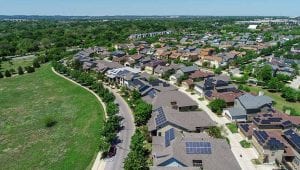Several years ago, Origin Energy managing director Grant King dismissed solar PV as little more than “panels in the paddock”. But it now emerges that these panels could be his company’s sharpest weapon against its competitors.
The reason is that Origin Energy has found itself “short” on generation, meaning that it does not own enough of its own capacity to meet the demand of its consumers.

That forces Origin Energy to buy output on the wholesale market, which means it gains an advantage if those prices are low, which is where they have been for the last few years because of the excess capacity in the market.
King acknowledged as much back in May, when he pointed out the impact of solar and wind and how they are removing the case for baseload generation.
Building new large-scale solar plants is likely to further dampen wholesale prices, particularly in Queensland, where the state-owned coal generators have already been exposed to the impact of rooftop solar, which has largely taken away the midday and daytime premium on wholesale prices, when expensive gas generators used to run.
In a market where wholesale prices are falling, that is potentially an advantage to Origin Energy, which has a greater proportion of its power fleet in more “flexible” generation, such as gas-fired generators, that can cope with the variations in wind and solar output.
Origin Energy has already said that it is looking at the opportunities for big solar in Queensland, because of its relatively high wholesale prices and its excellent solar resources, and the fact that demand could grow because of the boom in big LNG export terminals (of which Origin Energy is a part owner of one).
Bloomberg New Energy Finance says the Queensland market is the one market in the main grid that could support a large amount of solar. It predicts that half of the 5,500MW capacity needed to fill the renewable energy target could come from large-scale solar.
This is a lot more than the 700MW expected when the Department of Environment crunched its numbers in May on the reduced RET, which may explain why the Abbott government is keen to see large-scale solar projects supported by the likes of the Clean Energy Finance Corp, and not wind.
The outlook for big solar in the state is looking increasingly good. Solar Choice has obtained council approvals for a 1GW mega solar farm on the Darling Downs, FRV is progressing a 150MW solar project in the north of the state, Windlab is considering a huge wind and solar complex inland from Townsville that could include a 600MW solar farm, and Ratch is looking at a 50MW solar PV facility at the old Collinsville power station. Numerous other projects are also in the pipeline.
The position of Origin Energy and its interest in big solar has been one of the big discussions on the sidelines of the Clean Energy Summit in Sydney this seek.
BNEF’s Kobad Bhavnagri said in one session on Wednesday that Origin Energy could be in a position where it could use the deployment of large-scale solar to squeeze generators in Queensland, including the state-owned Stanwell and CS Energy, and other groups long on baseload coal generation elsewhere in the market, including AGL Energy and Energy Australia.
But Bhavnagri also noted that it could precipitate a fundamental shift in the make-up of Australia’s big gentailers, particularly if Origin Energy saw the opportunity of being “short” generation to have a renewables heavy portfolio.
“If one goes it starts an arms race,” Bhavnagri said. “It would be a wonderful outcome for the market.”
The irony is that AGL Energy, which used to be heavily renewables focused, is now “long” baseload generation following the purchase of the Loy Yang A and the Liddell and Bayswater coal-fired generators in NSW.
Bhavnagri pointed to the lessons of Germany, where the big utilities were not only slow in the uptake of rooftop solar and storage, and allowed numerous competitors into the market, but also on large-scale renewables – accounting for less than 10 per cent of all installations.
The figures in Australia are similar, with the three biggest retailers accounting for 70 per cent of customers owning just 10 per cent of renewable energy capacity (and 7 per cent of rooftop solar).
This, Bhavnagri says, is a gamble. There is talk that power purchase agreements are becoming hard to obtain because of an effective “buyers’ strike”, possibly based on the assumption that the renewable energy target may again be cut, particularly if a Coalition government is re-elected with numbers in the Senate.
But if the retailers don’t move, the plowback from consumers could be significant. “They are gambling against losing reputational damage, and also gambling on their portfolio,” he said.









